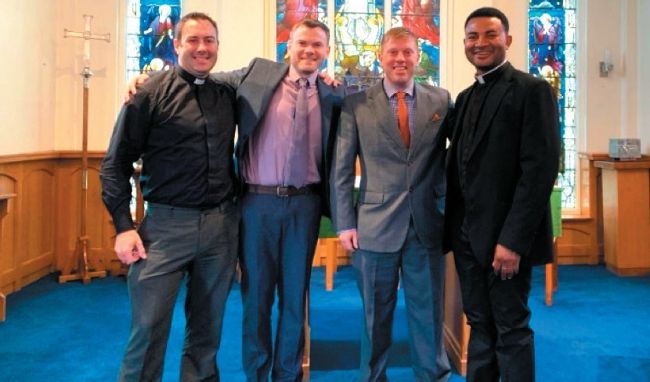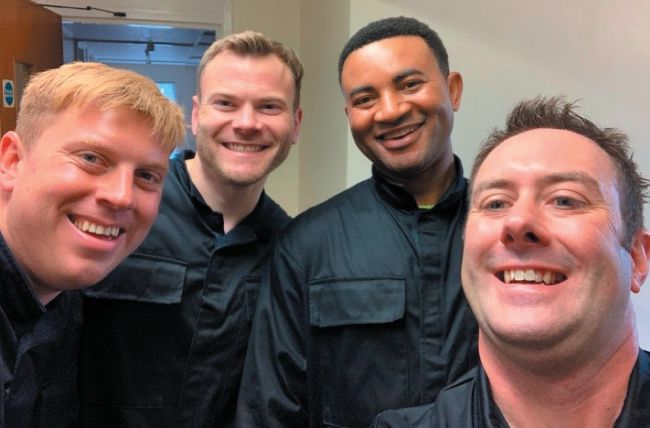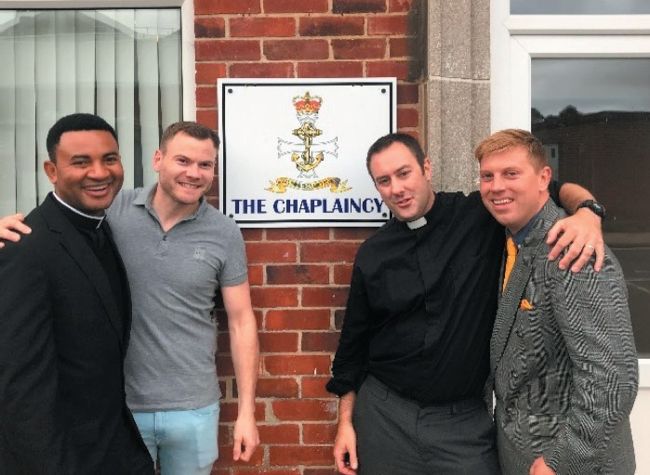A unique place
Jackie Macadam discovers recruitment to Royal Naval chaplaincy has changed and hears from a minister who has come through the revised training programme.
Jackie Macadam

Leftto right: Rev Neil Robertson, Church of England Rev David Young, Church of Scotland Rev Mike Woodall, Baptist Rev Victor Dakwan, Roman Catholic
EVERY year at the General Assembly, part of a morning is devoted to the report of the Church of Scotland’s Committee on Chaplains to Her Majesty’s Forces. It’s a morning where uniforms are on display and there is the chance to thank those ministers who work with people in sometimes dangerous and always challenging, situations.
Military chaplains are non-combatants so don’t carry weapons, but to become a military chaplain, they normally have to undergo a similar recruitment process as soldier, sailor and airman/woman candidates do. At least, as far as the Royal Navy is concerned, that’s been the case until recently. The Rev Martin Evans RN, the chaplain recruiter based in Portsmouth, explained:
“Naval chaplains like to insist that St Paul was the first naval chaplain, although not a very lucky one. Thankfully most naval chaplains have not been shipwrecked in a history of ministry to those ‘that go down to the sea in ships’ which stretches back many centuries.
“Sailors and Marines of all different specialisations in the Naval Service each have a unique and important role to play and the Chaplain is no exception – in a professional and hardworking community, the adage rings true: ‘The Team Works’.
“As you might expect of someone who, first and foremost, is called by God for leadership in the Church, the Chaplain on board a warship or in a Commando Unit perhaps stands apart in a more obvious way. For a start, he or she is a noncombatant, not able to bear arms, but they are also called specifically to be ‘a friend and advisor to all on board’, from the Captain of the ship to the most junior sailor, from the Commanding Officer to the youngest marine.
“It’s a special calling that not everyone is cut out for.”
Martin said: “To fulfil such a role is an enormous challenge, especially when away from the familiarity of your Church community, without many of the familiar props of parish ministry – it calls for great spiritual resilience and a strong sense of identity as a leader in the Church’s Mission, even in some of the world’s most hostile places. Leadership is certainly required of the Royal Navy’s chaplains but not necessarily in a typical military sense.”
“Chaplains have a truly unique place in the ‘pecking order’ as they minister to those who serve across the Naval Service in every rank. It is crucial that they are equipped and ready to fulfil that role.
And that’s where the changes to the entry process have been focussed.
“The Royal Navy, has recognised the special skill set required of its chaplains and has taken the bold initiative of reviewing the way in which clergy are assessed as to their suitability to enter the Navy as chaplains,” Martin explained. “Before this assessment, clergy who may feel called to serve in the Royal Navy as chaplains usually test their vocation by having a closer look through attending an Acquaint Visit. This allows them to see ‘up close’ the ministry of a naval chaplain in a number of different contexts. If they like what they see, after some obligatory form-filling and a medical, they are put forward for a more thorough test in the shape of the Admiralty Interview Board.
“The first Admiralty Interview Board (the acronym ‘AIB’ is usually used) was inaugurated in 1903 by Lord Fisher of Kilverstone OM, GCVO, KCB when he was the Second Sea Lord. It has been, and remains to this day, a fair, objective and transparent process for those aspiring to join the Royal Navy and become an officer, including those being commissioned from the ranks.
“The Royal Navy is rightly proud of this remarkable means of selection which has become something of an institution. Generations of naval officers have been through it. It looks for, amongst others, qualities like leadership, the ability to command a team of sailors.
“We in the Naval Chaplains branch, began to wonder if it was actually an effective means for assessing clergy and their suitability to become chaplains in our nation’s ‘Senior Service’?” he said.
“As well as being a non-combatant, unlike their colleagues in their sister services, naval chaplains do not carry rank, other than that of ‘Chaplain RN.’ This gives them a unique ability to move between mess decks in a ship, up and down the rank spectrum in a non-threatening way, if only to check up on the Ship’s Company.
“Most sailors will be missing their parents, partners or children depending on their stage in life – just occasionally it might even be possible to find someone who is missing seeing a grandchild! More thorny pastoral issues may emerge as the chaplain becomes a well-known personality on board and wins the trust of her or his ‘shipmates’.
“But are these challenges the same as faced by officers? We didn’t think so.
“With the help of a newly ratified Competency Framework outlining the Skills, Knowledge and Attitudes required of a Naval Chaplain, the AIB Team with the help of a consultant got to work making appropriate changes to the way potential naval chaplains were assessed. An experienced chaplain would sit on the board who could ask more probing questions about subjects as diverse as working ecumenically in a Chaplaincy Team to dealing with a bereaved sailor. We felt that the new entry procedures would be much more appropriate for the work of a Chaplain as distinct from an officer.
Chaplain as distinct from an officer. “Chaplains are commissioned into the Royal Navy but as ‘Chaplains RN’ and it is as chaplains they will need to live out their vocations. With the absence of any sign of rank on a naval chaplain’s uniform (instead a cross, overlaid with a spoiled anchor, can be seen on a chaplain’s epaulettes indicating the chaplain’s ‘role’ rather than ‘rank’), Chaplains have a truly unique place in the ‘pecking order’ as they minister to those who serve across the Naval Service in every rank. It is crucial that they are equipped and ready to fulfil that role.
“The Acquaint Visits are an important part of the process but the new training course lasting 16 weeks, will prepare civilian clergy for the military challenges ahead, but they must have the inner strength and an openness to allow themselves to be pushed outside their comfort zone, usually alongside others many years their junior. Most of all though, they need simply to show a deep and sincere faith in the God who has called them to be who they are, where they are, ambassadors for Christ in an environment which is as exciting as it is challenging every day.”
And the new approach by the Navy appears to be bearing fruit.
“The first ever Chaplain-specific AIB took place in September last year and was a resounding success,” Martin explained. “All four candidates had a clear understanding of God’s call to naval chaplaincy, it was clear they had thought and prayed hard about the decision to join; they all had a natural interest in, and commitment to, the people who make the Royal Navy the world class organisation it is and they were all, as you can see, delighted with the outcome!” The Rev David Young, Church of Scotland minister at Helensburgh, l/w Rhu and Shandon, was one of the four newly recruited chaplains to come through the first of the new AIB tests.
David’s eyesight was not good enough to allow him to become a full-time naval chaplain on a ship – but thanks to the new course, he’s still been able to answer his calling, in the Naval Reserve in Glasgow.
“I’ve felt called to Chaplaincy in the Royal Navy since I was a teenager. I even completed the first ever full-time placement with the RN Chaplaincy Service as part of my ministry training in 2004. After many setbacks due to my eyesight, I was finally given the green light.

During the Admiralty Interview Board: Mike, David, Victor and Neil

After the Admiralty Interview Board: Victor, David, Neil and Mike
“I attended the Admiralty Interview Board (AIB) at HMS Sultan, a shore base in Hampshire, from September 11 to 12 2019. The AIB is a competency-based assessment and I was one of four candidates in a brand new Chaplain-only syndicate, working alongside another syndicate of four candidates presenting themselves to be assessed for different roles.
“After settling in, we mustered in the common room for a welcome brief by a Board member who offered words of encouragement and reminded us to be ‘our most confident self’.
“The first task was the Royal Navy Fitness Test (RNFT). We had just a few minutes to change into our PT rig, and muster in the common room. The test sets an agedependent time to run 2.4km. Thankfully, being 36 at the time, I had 13 mins and 37 secs to complete. They don’t reveal your time but I came second out of eight candidates, beaten only by a 22-year-old so, I reckon I didn’t do too badly!
“Then it was onto the bus to head to the Practical Leadership Task (PLT) hangar. This is a dedicated AIB space with various pieces of equipment used to complete scenariobased tasks. We were told about health and safety and the correct way to move planks, barrels and ropes, and the all-important placement of fingers. We learned which commands were appropriate and which were not! After a few practice runs it was back to base camp where we received a brief about the Planning Exercise (PLANEX). The PLANEX and the PLTs assess our ability to identify a problem, work together to agree and execute a solution. This assesses our effective intelligence, adaptability and initiative, teamwork and collaboration, communication and influence.
“The rest of day one was about getting to know our team. We practised some more PLT commands and techniques and then headed – as is encouraged – to the pub to further get to know one another in a relaxed atmosphere.
“Assessment day started sharp at 0615. At 07.15, the first task for our syndicate was the PLANEX. We were each given a folder, pencil and blank paper to take notes. No talking was permitted. On a signal we had 15 minutes to open the book, study the scenario, suggest possible solutions and formulate our own plan. We were then, in silence, marched into the Board Room where the assessors – Board President, the Chaplain of the Fleet and a Lieutenant – were waiting, along with an independent auditor who was assessing them! In front of us was a representation of our scenario – a volcano had erupted on an island, people were stranded, equipment was damaged, the ship was far away, the radio and transmitter was knackered, we had little equipment and limited time. What were we going to do?
“We were asked individual questions in quick succession to assess how we react under pressure. The briefing folder for the scenario was full of red-herrings and we had to memorise as much as possible. If we didn’t know the answer, the interviewer went straight to another candidate until someone answered. She was skilled in the art of planting seeds of doubt! We then had to go away and type up our solution to the scenario but not before we were given an additional piece of information which changed my solution entirely.
“I returned, on my own, to the Board Room, to brief (without notes) the officer my plan. Following questions, I was dismissed. There was no time to dwell on the success or otherwise of the task.
“Then it was back to the hangar. Unlike other candidates we were not given a PLT scenario and 15 mins to come up with a solution. Chaplains are never in command so our collaborative and communication skills were tested instead. We had 10 minutes (non-chaplain candidates have 15 mins to plan and eight to execute) to discuss our problem, agree a solution and execute it, for both a dry and a wet task. “There is a swimming pool in the hangar and you need to be prepared to get wet! We built cantilevers across chasms, tied ropes together, moved planks of wood, transported barrels and completed both tasks within the allocated time. Although completion of the exercise is not what’s being assessed, we were chuffed to bits that we finished! The Board President – concerned that only two of the chaplaincandidates ended up in the water (I was one of them) – politely reminded us that in the Navy we are part of a team and all were ordered to jump in and dive under! I’d pay good money to take a team from my congregations for a day of PLTs!
“After returning to the AIB suite, and a tidy up, it was time for individual interviews which lasted around an hour to allow the Board to get to know and understand each candidate. My motivation for and understanding of RN Chaplaincy, sense of self, values, morals, understanding of the nature of war and the non-combatant status of clergy, and my experience to date were discussed.
“Then it was time to wait for a decision. Seven out of the eight candidates from both syndicates passed – and I was one of them. I was relieved and exhausted, and felt an enormous sense of achievement.
“This has been a long journey for various reasons but I am now Probation Chaplain to HMS Dalriada in Govan. I am excited to be embarking upon my training and look forward to working with and serving alongside the many men and women who make up our Royal Navy.”